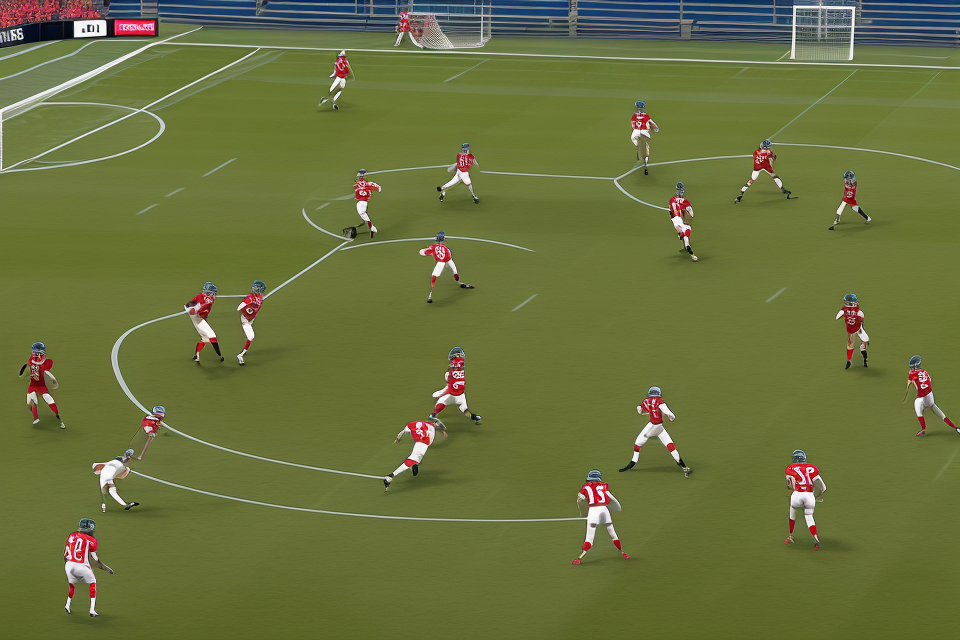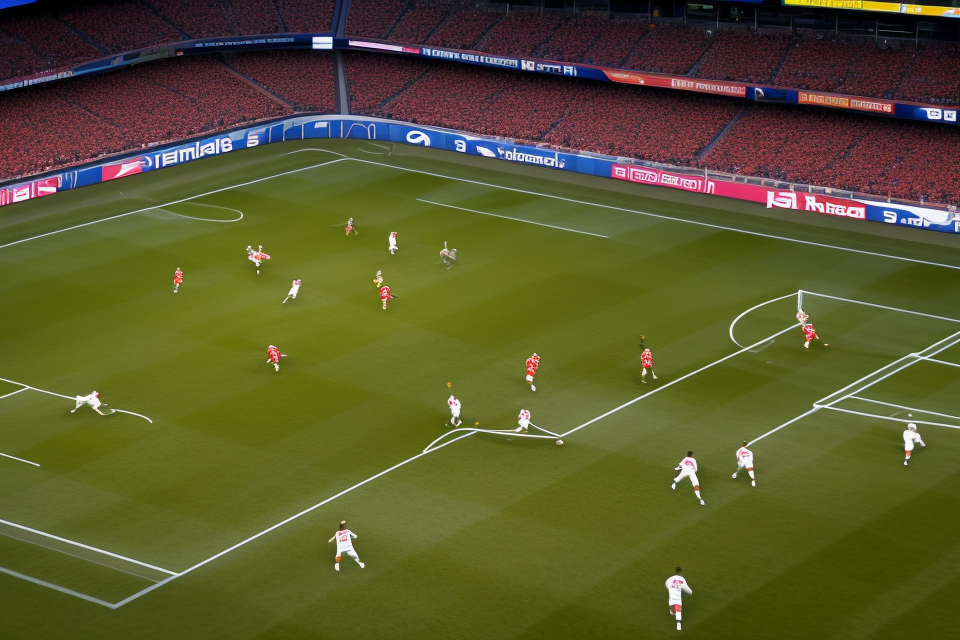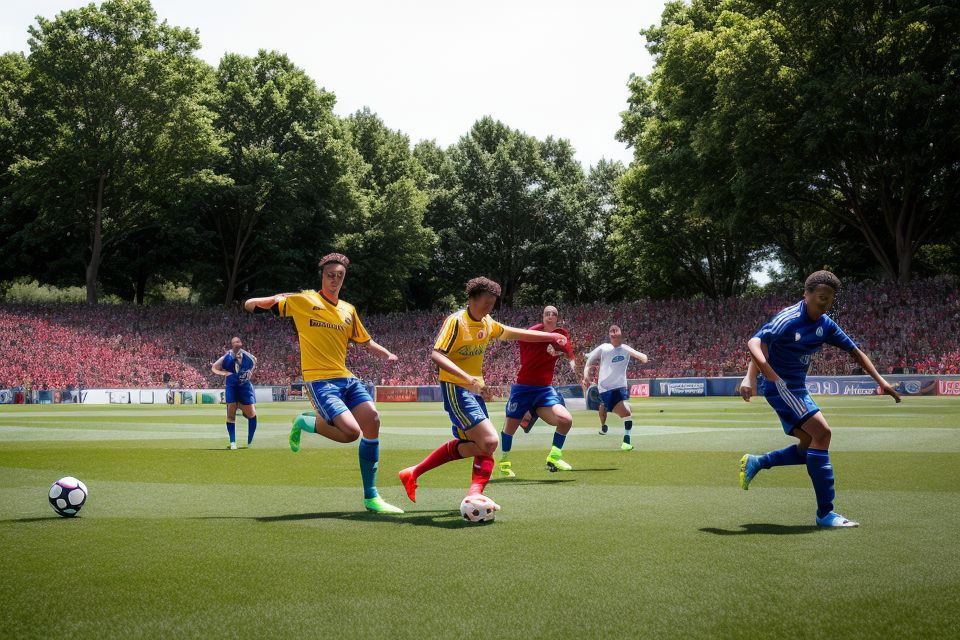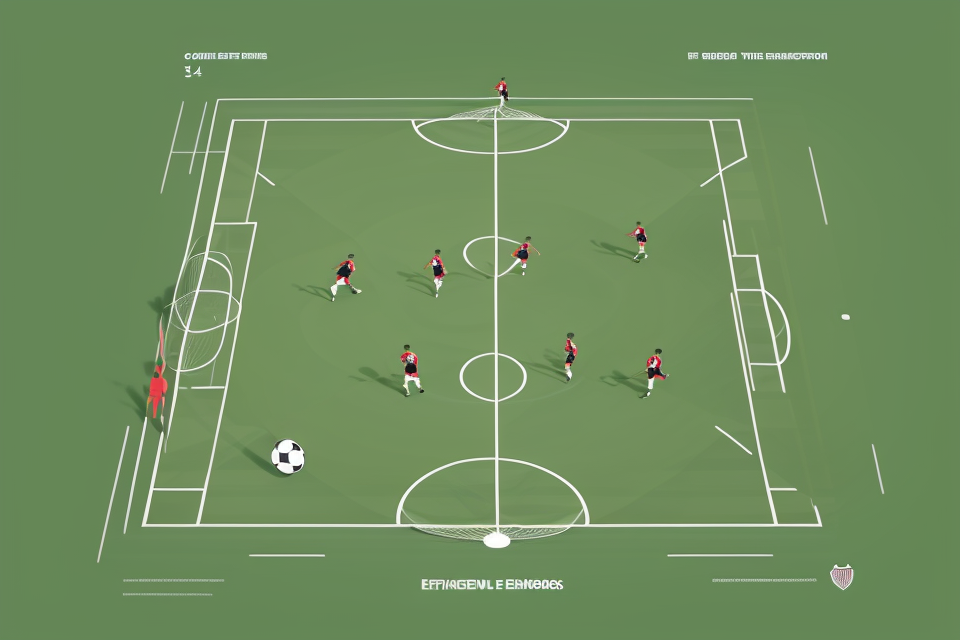Football is a game of strategy and tactics, where teams use various techniques to outsmart their opponents. From defence to attack, each tactic has its own set of advantages and disadvantages. In this article, we will explore the three most common football tactics used by teams today. These tactics are designed to exploit weaknesses in the opposing team’s defence, while also protecting the team’s own defence. Whether you’re a fan of the game or a player, understanding these tactics can help you appreciate the game on a whole new level. So, let’s dive in and explore the tactics that are making waves in the world of football.
The three most common football tactics used by teams today are: 1) the 4-4-2 formation, which involves four defenders, four midfielders, and two forwards; 2) the 3-5-2 formation, which involves three defenders, five midfielders, and two forwards; and 3) the 4-3-3 formation, which involves four defenders, three midfielders, and three forwards. These formations are chosen based on the team’s strengths and weaknesses, as well as the opposing team’s strengths and weaknesses. Teams may also use a variety of other tactics, such as pressing, possession-based play, and counter-attacking, to gain an advantage on the field.
Understanding Football Tactics
The Importance of Football Tactics
Football tactics refer to the strategies and techniques employed by teams during a match to achieve their objectives. These objectives may include winning the game, controlling possession, preventing the opposition from scoring, or exploiting the weaknesses of the opposing team.
The role of football tactics in a match cannot be overstated. It is what sets successful teams apart from unsuccessful ones. A well-thought-out tactical plan can help a team dominate the game, while poor tactics can lead to defeat.
Tactics have evolved over time, with new ideas and strategies constantly being developed and refined. Coaches and managers spend countless hours analyzing opponents and devising tactics to outwit them. In this way, football tactics have become a crucial part of the game, and teams that neglect them do so at their own peril.
Types of Football Tactics
Football tactics can be broadly categorized into three main types: offensive tactics, defensive tactics, and transition tactics. These tactics are used by teams to achieve specific objectives on the field and gain an advantage over their opponents.
- Offensive Tactics: These tactics are employed by teams to score goals and gain control of the game. They involve the positioning of players, movement off the ball, and the use of different attacking formations. Common offensive tactics include:
- Through-balls: This tactic involves passing the ball through the opponent’s defense to create a scoring opportunity.
- Wing-play: Wingers are positioned higher up the field and make runs down the flanks to create crossing opportunities or to cut inside and shoot.
- Counter-attacks: This tactic involves quickly transitioning from defense to attack, exploiting the opponent’s disorganization after losing possession.
- Defensive Tactics: These tactics are used by teams to prevent the opponent from scoring and gain control of the game. They involve the positioning of players, marking, and the use of different defensive formations. Common defensive tactics include:
- Zonal Marking: Players are assigned specific areas of the field to defend, rather than man-marking individual opponents.
- Line-splitting: This tactic involves passing the ball through the opponent’s defense by splitting their lines, creating space for a teammate to run into.
- Offensive-minded Fullbacks: Modern fullbacks are often positioned higher up the field and involved in attacking plays, providing width and support to the team’s offense.
- Transition Tactics: These tactics are used by teams to quickly transition from defense to attack or vice versa. They involve the positioning of players, ball possession, and the use of different formations. Common transition tactics include:
- Pressing: This tactic involves aggressively closing down opponents and regaining possession quickly after losing the ball.
- Counter-pressing: This tactic involves quickly pressing the opponent after they lose possession, attempting to win the ball back and launch a counter-attack.
- Ball-recovery: This tactic involves positioning players to quickly recover the ball and transition to attack, exploiting the opponent’s disorganization after losing possession.
The Three Most Common Football Tactics
Tactic 1: The 4-4-2 Formation
Overview of the 4-4-2 Formation
The 4-4-2 formation is one of the most common tactics used by football teams today. It is a formation that features four defenders, four midfielders, and two forwards. The formation is named after the number of players in each line of the field. The two forwards in the front line are usually the team’s main attacking threat, while the four midfielders provide support and cover for the defense.
Strengths and weaknesses of the 4-4-2 formation
One of the main strengths of the 4-4-2 formation is its flexibility. The formation allows teams to play a variety of different styles, from direct and physical to more possession-based and technical. The two forwards in the formation can also provide a potent attacking threat, with one forward acting as a target man and the other playing more on the wing.
However, the 4-4-2 formation also has some weaknesses. One of the main weaknesses is that it can leave the team vulnerable to counter-attacks, as the two forwards can be caught out of position when the team is defending. Additionally, the formation can be vulnerable to narrow spaces in midfield, as the four midfielders can become congested and leave gaps between the lines.
Teams that have successfully used the 4-4-2 formation
Despite its weaknesses, the 4-4-2 formation has been used successfully by many teams over the years. One of the most famous teams to use the formation was Manchester United under the management of Sir Alex Ferguson. The team won numerous titles and trophies during the 1990s and early 2000s using the 4-4-2 formation, with players like Eric Cantona and Ryan Giggs leading the attack. Other teams that have used the 4-4-2 formation to success include Arsenal, AC Milan, and Bayern Munich.
Tactic 2: The 3-5-2 Formation
Overview of the 3-5-2 Formation
The 3-5-2 formation is a tactical system used in football that involves three central defenders, five midfielders, and two forwards. This formation is commonly used by teams that prefer a more defensive approach to the game, as it provides an extra layer of protection in the backline. The three central defenders are typically positioned in a row, with one of them acting as a sweeper or ball-playing defender. The five midfielders are positioned in front of the defense, with two of them playing as more defensive-minded players and the other three playing as more attacking-minded players. The two forwards are positioned upfront, with one of them typically playing as a target man and the other as a more creative player.
Strengths and weaknesses of the 3-5-2 formation
One of the main strengths of the 3-5-2 formation is its ability to provide a strong defensive presence on the field. With three central defenders, the team is able to cover more ground and better protect the goal. Additionally, the formation allows for a lot of flexibility in the midfield, with the ability to play both defense-minded and attack-minded players. This can help the team control the pace of the game and create scoring opportunities.
However, the 3-5-2 formation also has some weaknesses. One of the main weaknesses is the lack of support for the fullbacks, as there are only two players on the flanks. This can make it difficult for the team to defend against fast-moving wingers and can leave the fullbacks exposed. Additionally, the formation can be difficult to execute effectively, as it requires a lot of communication and coordination between the different players.
Teams that have successfully used the 3-5-2 formation
There have been several teams that have successfully used the 3-5-2 formation over the years. One of the most notable examples is the Italian national team, which used the formation to great effect during their successful World Cup campaign in 2006. Other teams that have used the formation include AC Milan, Real Madrid, and Bayern Munich.
Overall, the 3-5-2 formation can be a very effective tactical system for teams that want to emphasize defense and control the midfield. However, it requires a lot of skill and coordination to execute effectively, and teams must be careful to avoid the weaknesses associated with the formation.
Tactic 3: The Pressing Game
The pressing game is a tactic that involves a team pressing high up the pitch, putting pressure on the opposition and attempting to win the ball back as quickly as possible. This tactic is often used by teams that are looking to dominate possession and create scoring opportunities through quick transitions.
Strengths and weaknesses of the pressing game
One of the main strengths of the pressing game is that it can disrupt the opposition’s build-up play, making it difficult for them to play out from the back. This can lead to turnovers and counter-attacking opportunities for the team employing the pressing game. Additionally, by winning the ball high up the pitch, the team can avoid having to defend deep in their own half, which can lead to more space and opportunities to attack.
However, there are also weaknesses to the pressing game. If not executed properly, it can leave the team vulnerable to counter-attacks, as the opposition can exploit the spaces left behind by the pressing players. Additionally, the pressing game can be physically demanding, and if the team is not properly prepared, they may struggle to maintain the intensity required to execute the tactic effectively.
Teams that have successfully used the pressing game
There have been many teams that have successfully used the pressing game in recent years. Some examples include:
- Jürgen Klopp’s Liverpool: Under Klopp, Liverpool became known for their high-intensity pressing game, which helped them win numerous trophies, including the Champions League in 2019.
- Pep Guardiola’s Manchester City: Guardiola’s City teams have also employed the pressing game, with great success. They have won multiple Premier League titles and reached the Champions League final on several occasions.
- Hansi Flick’s Bayern Munich: Flick’s Bayern Munich side used a pressing game to great effect, winning the Champions League in 2020 and going on to win the Bundesliga title.
Other Football Tactics
Counter-Attacking Football
Counter-attacking football is a tactic used by teams to quickly transition from defense to offense, exploiting the opponent’s weaknesses and catching them off guard. This tactic is often used by teams that have a strong defense and are looking to capitalize on the opponent’s mistakes.
Overview of Counter-Attacking Football
In counter-attacking football, the team focuses on quickly moving the ball up the field and taking advantage of any opportunities to score. This tactic involves the team being highly organized and disciplined, with all players understanding their roles and responsibilities.
Strengths and Weaknesses of Counter-Attacking Football
One of the main strengths of counter-attacking football is that it can catch the opponent off guard, allowing the team to exploit any weaknesses in their defense. Additionally, this tactic can be highly effective against teams that are more possession-based, as it allows the team to control the pace of the game and limit the opponent’s opportunities to attack.
However, there are also weaknesses to this tactic. If the team is not well-organized or disciplined, it can be easily exposed and caught out of position. Additionally, if the team is not able to score quickly, it can leave itself vulnerable to counter-attacks from the opponent.
Teams that have Successfully used Counter-Attacking Football
There have been many teams that have successfully used counter-attacking football to great effect. Some examples include:
- Bayern Munich: Under manager Niko Kovac, Bayern Munich used counter-attacking football to great effect, particularly in the 2019-2020 season, where they won the Bundesliga title.
- Liverpool: Under manager Jürgen Klopp, Liverpool has also used counter-attacking football to great effect, particularly in the 2019-2020 season, where they won the Premier League title.
- Atletico Madrid: Under manager Diego Simeone, Atletico Madrid has also used counter-attacking football to great effect, particularly in the 2013-2014 season, where they reached the Champions League final.
Tiki-Taka Football
Overview of Tiki-Taka Football
Tiki-taka football is a tactical approach to the game of football that emphasizes short passing and quick movement of the ball. The term “tiki-taka” originated from the Catalan language and is derived from the words “tiki” meaning “touch” and “taka” meaning “take.” The tiki-taka style of play is characterized by close ball control, quick passing, and a high pressing game.
Strengths and Weaknesses of Tiki-Taka Football
One of the main strengths of tiki-taka football is its ability to control the tempo of the game. By constantly passing the ball, teams can slow down the pace of the game and create space for their players to make moves. This approach also allows teams to maintain possession of the ball, which can lead to more scoring opportunities.
However, tiki-taka football also has its weaknesses. One of the main drawbacks is that it can be difficult to execute effectively, as it requires a high level of technical skill and teamwork. Additionally, tiki-taka football can be vulnerable to counter-attacks, as teams that use this approach may be caught out of position if they lose possession of the ball.
Teams that have Successfully used Tiki-Taka Football
One of the most successful teams to use tiki-taka football is the Spanish national team, which won the 2010 FIFA World Cup using this approach. Other teams that have had success with tiki-taka football include Barcelona, Real Madrid, and Bayern Munich. These teams have used tiki-taka football to dominate their opponents and win numerous championships and titles.
Possession Football
Possession football is a tactic used by teams to control the ball during a match. The objective of this tactic is to maintain possession of the ball for as long as possible, limiting the opposition’s chances to score. This tactic requires the team to have exceptional passing skills, close control, and quick decision-making.
Strengths and Weaknesses of Possession Football
The strength of possession football lies in its ability to control the pace of the game. By keeping the ball, the team can limit the opposition’s opportunities to score, while also creating chances for themselves. Additionally, possession football allows teams to tire out their opponents, as they are constantly chasing the ball.
However, there are also weaknesses to this tactic. The main weakness is that it can be predictable, making it easy for opponents to defend against. Additionally, possession football can be physically demanding, leaving players exhausted towards the end of the match.
Teams that have Successfully used Possession Football
There have been many teams that have successfully used possession football, including Barcelona, Spain, and the Netherlands. These teams have used possession football to great effect, dominating matches and winning trophies.
Barcelona, in particular, has been known for its tiki-taka style of possession football, which involves quick passing and movement off the ball. This style of play has been instrumental in Barcelona’s success, helping them win numerous La Liga titles and Champions League trophies.
In conclusion, possession football is a tactic that requires exceptional passing skills, close control, and quick decision-making. While it has its strengths, such as controlling the pace of the game and tiring out opponents, it also has weaknesses, such as being predictable and physically demanding. Despite this, many successful teams have used possession football to great effect, including Barcelona, Spain, and the Netherlands.
The Future of Football Tactics
- The impact of technology on football tactics
Football has always been a sport that is constantly evolving, and with the advent of new technologies, this evolution is happening at an even faster pace. From data analytics to virtual reality, technology is playing an increasingly important role in the world of football.
One of the most significant ways that technology is impacting football tactics is through the use of data analytics. Teams are now able to collect and analyze vast amounts of data on their opponents, which allows them to better understand their strengths and weaknesses. This, in turn, enables them to develop more effective tactics and strategies to beat their opponents.
Another way that technology is changing football tactics is through the use of virtual reality. This technology allows teams to simulate different game scenarios and test out different tactics in a controlled environment. This can help teams to identify potential weaknesses in their tactics and make adjustments before the actual game.
- The future of football tactics
As technology continues to advance, it is likely that we will see even more changes in the world of football tactics. One trend that is already emerging is the use of artificial intelligence (AI) to analyze game data and make predictions about how the game will unfold. This technology has the potential to revolutionize the way that teams prepare for games and develop their tactics.
Another trend that is likely to continue is the emphasis on fitness and athleticism. As the game becomes more physical, teams are placing a greater emphasis on conditioning and strength training to give their players an edge on the field. This, in turn, is leading to the development of new training methods and techniques that are designed to improve players’ physical abilities.
- Emerging football tactics
In addition to these technological changes, there are also emerging football tactics that are being developed and tested by teams around the world. One trend that is gaining popularity is the use of pressing tactics, which involve teams applying high pressure to their opponents in an attempt to win the ball back quickly. This tactic requires teams to be highly organized and disciplined, but can be very effective when executed properly.
Another emerging tactic is the use of counter-attacking football, which involves teams using their speed and agility to quickly transition from defense to offense. This tactic requires teams to be highly tactical and able to take advantage of their opponents’ mistakes, but can be very effective when executed properly.
Overall, the future of football tactics is likely to be shaped by a combination of technological advancements and emerging trends. As teams continue to look for ways to gain an edge on their opponents, we can expect to see a wide range of new tactics and strategies emerge in the years to come.
FAQs
1. What are the three most common football tactics used by teams today?
There are many different tactics that football teams use, but some are more common than others. Three of the most common football tactics used by teams today are:
1.1. The 4-4-2 formation
The 4-4-2 formation is one of the most common formations in football. It involves four defenders, four midfielders, and two forwards. This formation is often used because it provides a good balance between defense and attack, and it allows teams to have a lot of control over the midfield.
1.2. The counter-attacking strategy
Counter-attacking is a strategy that involves hitting the opponent on the break when they are out of position. This strategy is often used by teams that are not as skilled or talented as their opponents, but it can be very effective if executed properly. To be successful with this strategy, teams need to have fast players who can quickly transition from defense to attack.
1.3. The possession-based strategy
A possession-based strategy involves keeping the ball as much as possible and controlling the game. This strategy is often used by teams that have more skilled players and are able to keep the ball for long periods of time. The idea is to tire out the opponent and create scoring opportunities through sustained pressure.
2. What is the 4-4-2 formation?
The 4-4-2 formation is a common football formation that involves four defenders, four midfielders, and two forwards. This formation is often used because it provides a good balance between defense and attack, and it allows teams to have a lot of control over the midfield. The four defenders are typically positioned behind the midfielders, while the two forwards are up front and responsible for scoring goals.
3. What is counter-attacking?
Counter-attacking is a strategy that involves hitting the opponent on the break when they are out of position. This strategy is often used by teams that are not as skilled or talented as their opponents, but it can be very effective if executed properly. To be successful with this strategy, teams need to have fast players who can quickly transition from defense to attack. The idea is to catch the opponent off guard and take advantage of their mistakes.
4. What is a possession-based strategy?
A possession-based strategy involves keeping the ball as much as possible and controlling the game. This strategy is often used by teams that have more skilled players and are able to keep the ball for long periods of time. The idea is to tire out the opponent and create scoring opportunities through sustained pressure. Teams that use this strategy typically have a lot of possession and try to slow down the game to their advantage.



